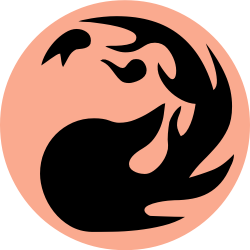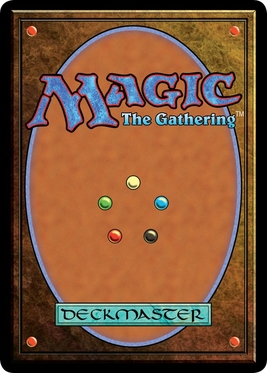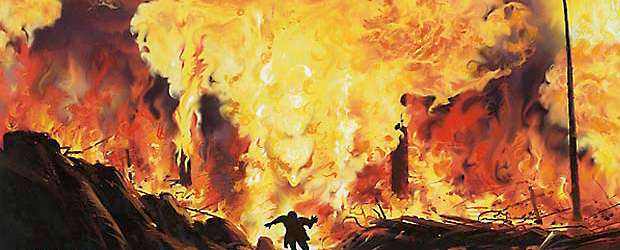Two weeks ago, I wrote the third post in this series on the color black, which is a fairly well-defined color in terms of its identity, but also a color on which I have many mixed feelings. This week, we'll be talking about red, which is a much simpler color in most respects.
Bottom left of the color pie!
So with that, let's continue on and talk about red!

What does red represent?
I mentioned in one of the earlier posts that the colors often (but not always) coincide with the classical elements of earth, wind, fire, and air. As you could probably guess by now, red is most closely related to the element of fire, and many of the things that fire represents. Fire is often a powerful element, but it also is the element of emotion and passion and chaos, which are all pretty close to the heart of what red represents. Red doesn't like order, and red doesn't like restrictions. Red prefers to have no limits, and to do whatever comes naturally to it. It's a whimsical color, and I mean that as "capricious" and not "fairies dancing in a meadow."
See? Whimsical.
While red is most closely related to fire, it also represents lightning and earth in many cases - both of these in a rather violent sense. Lightning is represented in terms of its powerful and capricious nature, while earth is usually depicted in an explosive sense. It's never stability and durability with red, but rather explosions and earthquakes and volcanoes. Along with these ideas, as you could imagine, red does have many ties to nature, probably second only to green. But where green focuses on growth and the ferocity of nature's creatures (more on that two weeks from now), red is focused more on nature's capacity to be violent and random.
What does this mean for gameplay?
So how does red represent these themes in-game? The most important thing to remember about red is that it's the color of emotion, and it craves freedom and doing whatever comes naturally. That means that for red, the simplest solution is usually the correct one. How does one win a game of Magic? Generally by reducing the opponent to zero life. How does one reduce an opponent to zero life? Well, the simplest way is by dealing damage. Just... damage. Red is the biggest proponent of just throwing out spells that deal some amount of damage to a creature or player - or perhaps more appropriately, dealing some amount of damage to all creatures or players. It's also the color that most enjoys destroying artifacts. Essentially, red can be summed up with "Is it annoying? Do we not like it? Let's blow it up."
Again, red is a simple color. It doesn't need much explanation.
In terms of its creatures, there are a few trends that red follows. First off, like white, red is prone to having a lot of very small creatures charging at the enemy, whether that takes the form of an angry mob of ordinary humans or a horde of reckless goblins. Larger creatures in red often have very high power with a low toughness - in other words, they deal a lot of damage (read above), but die quickly. Elementals, minotaurs, and giants often fall into this category. These creatures often come with the haste ability, meaning they can attack on the turn they are played. Just like with red spells, red creatures are violent and capricious, and if you're playing against a red opponent, you're just as likely to be hit with a fireball as to be attacked by a rock elemental without warning. But as quickly as they appear, they're gone - if something red has decided to kill you, it's probably not thinking about its own survival.
And of course, we can't forget red's signature creature. Where black has the support of demons (if it can truly be called support), red has the power of dragons at its command. Dragons are like the epitome of red's philosophies, especially those regarding the violence of nature. So while a red deck's early creatures often focus on a horde of weaklings, it's not uncommon to see such a deck finish off the opponent by swooping in with a powerful dragon or two.
If you were looking for a sign to play a red deck...
...this is it.
Finally, another thing red is really known for is its randomness and chaos. As such, red is often where you'll find cards that ask you to flip a coin to determine which of two possible outcomes will occur, or you'll find a creature that attacks an opponent at random (which is really only applicable in multiplayer games, but still). This isn't really a majority of red cards, but it happens significantly more in red than in any other color. My favorite is Possibility Storm, which essentially replaces any spell you cast with another random spell of the same type from your deck.
Yeah, as much as red is a "simple" color, things can get
real complicated, real fast.
My opinions on the color:
So red is actually one of my less-preferred colors in the game. Not because I don't like it, per se, but personally, I like to play a very creature-heavy game. If I can swing with a creature for 20 damage at a time, I'm happy. And when it comes to big stompy creatures, my preference is for green over red, if only because I like my creatures to have a high toughness in addition to a high power. Red certainly has more options than green in terms of its non-creature spells, but I'm not as big on non-creature spells.
The other thing I don't really like about playing red is that it can be pretty boring on its own, at least to me. I like red with other colors, but not really on its own - to be fair, though, I have that complaint about most colors. Oftentimes, a mono-red deck is concerned only with winning the game as quickly as possible, and it can be a very polarizing game - either you have a good start to the game and win in about 5 turns, or you don't have a good start and there's nothing you can do to come back from it. To me, it's just not as interesting of a game as if you were playing, say, blue or black, and even if you have a rough start, you have the tools to manipulate the game to your advantage.
So overall, I personally am not a huge fan of playing red. However, I do quite enjoy the color when I do choose to play it, especially when making use of the chaotic and random cards like Possibility Storm or when combining it with colors like white or blue. And besides, who wouldn't want to dominate the game with a dragon or several, when it comes down to it?




No comments:
Post a Comment